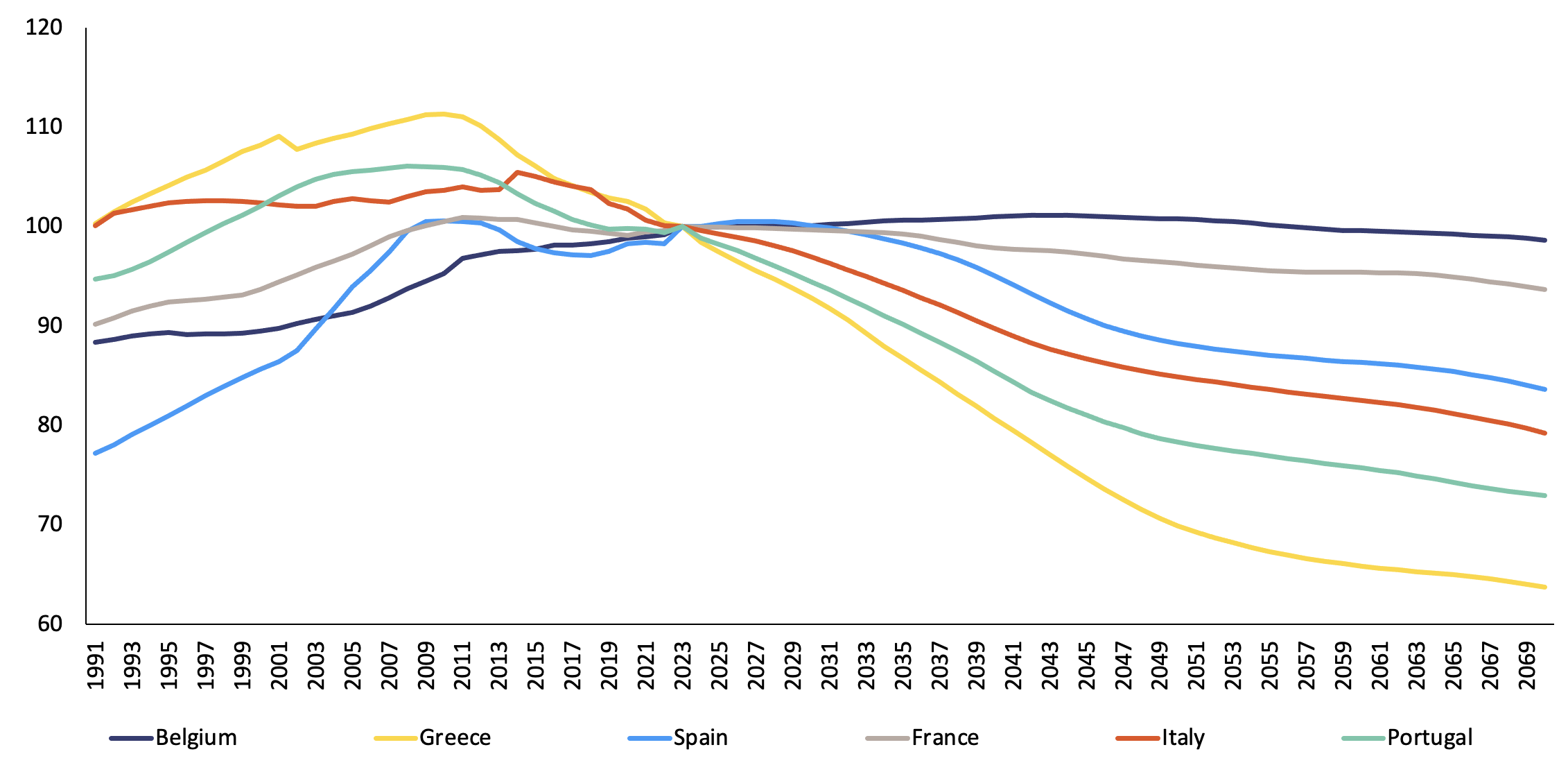The 2024-reform of the EU fiscal framework gives the EU fiscal rules a stronger medium-term orientation.
The objective is twofold: (i) put an end to the annual and ultimately unproductive quibbles about one or two decimal points of government deficit; and (ii) offer more stability in planning and implementing national fiscal policies. The new framework is built around an expenditure path for the next four to seven years, which – based on a comprehensive and cutting-edge debt sustainability analysis (DSA) – ensures that as a share of GDP government debt is put on a plausibly declining path.
Since the sustainability of national public finances has been the declared objective of the EU fiscal rules from the outset, experts concur that a DSA-based framework makes a lot of sense. The ‘old’ framework was associated with short-term one-size-fits-all requirements with limited consideration for country-specific elements that determine the evolution of government debt going forward. As a result, in some prominent cases the respect of such undifferentiated goalposts did not necessarily ensure a declining debt trajectory. The new approach is meant to avert such inconsistencies by taking into account elements beyond the annual primary budget balance driving the future evolution of government debt – notably, future rates of economic growth, the interest rates, and the costs of ageing.
This clear upside comes with an unavoidable drawback: forecasts, especially long-term projections, are surrounded by substantial uncertainty with implication for the fiscal adjustment needed to put and keep debt on a declining path. To address this uncertainty, the EU’s DSA framework contains three adverse deterministic scenarios and a stochastic examination.
The required fiscal adjustment is chosen such that, even under each of the unfavourable circumstances, government debt remains on a declining trajectory. The deterministic scenario of a worsening in the interest-growth differential
of 0.5% of GDP seems to be the most arduous shock for most EU countries. Indeed, given the long-time horizon of nearly 20 years in the EU’s DSA, any permanent shock to output growth will have a significant impact on the debt trajectory. Such a shock could be due to lower productivity growth or worse than expected demographic developments.
Our analysis simulates demographic shocks based on revisions of past vintages of working-age population projections and evaluates their impact on the debt trajectories within the EU’s revised fiscal framework. The focus is on EU member states with a high government debt burden where fewer and fewer people will have to shoulder the existing debt stock, and this trend may turn out more severe than we currently anticipate. To show this, we first calculate past revisions to Eurostat’s projections of working-age population (aged 20-64). We then assess the mechanical effect of these country-specific revisions on future economic growth.
In a final step, lower output growth ensuing from unfavourable demographics is introduced in the DSA to gauge the impact on the debt trajectory and how much more fiscal adjustment would be required to ensure a declining debt ratio. Of note, the analysis does not consider the impact of the simulated demographic shock on direct costs of ageing, which would further aggravate the fiscal challenge.
Demographic headwinds and uncertainties around projections
Our analysis spotlights EU countries with a debt-to-GDP ratio above 90% of GDP, namely, Belgium, France, Greece, Italy, Portugal, and Spain.
Given the large debt stock, these countries’ debt dynamics are particular susceptible to changes in output growth due to the denominator effect. At the same time, these countries are among those with the lowest fertility rates in the EU and their working-age population has already started to decline and is projected to continue to decline dramatically in some cases. For example, in Italy the working-age population is projected to shrink by close to 2 million people over the next ten years, after having already shrunk by 2 million people over the past ten years.
Figure 1 Working-age population projections in selected EU countries
Natural population growth follows a fairly predictable process determined by fertility and mortality rates, parameters that change only very gradually on a year-on-year basis. However, given the very long projection horizon and the impact of more volatile net migration, total population projections can and do significantly deviate from outturns. Eurostat’s demographic projections – the projections used in the EU’s DSA – are clearly labelled as ‘what-if scenarios’ that are exposed to an unusual degree of uncertainty.
Eurostat’s projections contain assumptions that could be considered as comparatively favourable. For example, national fertility rates are assumed to increase towards the rate of the best EU performers and net migration extrapolations are based on historical averages. UN (median) population projections expect a similar, even slightly higher, fertility rate compared to Eurostat. However, net migration assumptions are substantially more conservative.
As a result, Eurostat’s projections of working age population in 2050 for the combined six high-debt countries mentioned above are 13% higher than in the latest UN (median) projections.
Our analysis of Eurostat’s three vintages of Europop projections released between 2004 and 2010
reveals important difference between the 20-year-ahead projections of the working-age population and actual outturns,
with some vintages over-projecting and others under-projecting.
Concretely, compared to current estimates, the last two vintages for Italy over-projected the working-age population by 5 and 9 percentage points, respectively. In the case of Portugal and Greece, across all three vintages over-projections amounted to around 10 percentage points. Spain’s outturn on average confirmed projections, while in Belgium and France the working-age population grew more than expected. To the extent that the past provides clues about the future, these findings suggest that at least some high debt countries are likely to experience worse than expected demographic developments.
The impact of demographic shocks on debt and fiscal adjustment
Using the country-specific, average 20-year-ahead revisions of Eurostat’s projections, we simulate an additional demographic shock of the same size over the next two decades. Keeping employment rates and GDP per employed person fixed at the reference projections of the EU’s so-called ageing report, results in a significant decline of annual potential output growth (European Commission 2023). Consequently, the debt ratio may no longer be on a plausibly declining path even if the government implements the initially foreseen fiscal adjustment. If no additional fiscal adjustment is undertaken, the debt ratio at the end of the DSA horizon could in some countries end up 10% of GDP higher due to the adverse demographic shock.
In order to return to a plausibly declining debt trajectory, governments would either have to undertake an additional fiscal effort or boost future economic growth – for example, by raising productivity or increasing employment.
Neither of these is easy to do, especially at the scale needed. If governments choose the fiscal policy option, the required additional adjustment could for some high-debt countries reach 0.2% of GDP annually over the medium term. This may seem negligible at first but accumulated over the years and coming on top of already sizeable required fiscal adjustment it poses quite a challenge for governments.
Conclusion
Long-term demographic projections are surrounded by an exceptionally high degree of uncertainty and their implications for fiscal policy can be formidable especially for high-debt countries. The reformed DSA-based EU fiscal framework allows for downside risks to determine a plausibly declining debt trajectory. However, whether these safeguards are sufficient cannot be taken for granted. First, for some high-debt countries past revisions of demographic projections have been very sizeable in a context when population was still growing. Second, the EU’s DSA implicitly accounts for demographic risks but these risks are bunched together with productivity, the other main aggregate driver of potential output growth. It is not clear whether the correlations between demographic shocks and shocks to other growth drivers are constant over time – especially going forward. Third, and linked to the previous two points, the DSA’s safety margins are supposed to protect against a mix of different shocks. If we assume the demographic shock occurs in line with our (admittedly simple but still relevant) analysis, then for some countries this may leave no margin to absorb other shocks that are likely to occur along the way.
Authors’ note: The views expressed in this column are those of the authors and do not necessarily reflect those of the European Fiscal Board or the European Commission.
References
Darvas, Z, L Welslau and J Zettelmeyer (2023), “A quantitative evaluation of the European Commission’s fiscal governance proposal”, Bruegel Working Paper, 18 September.
European Commission (2023), 2024 Ageing Report: Underlying Assumptions and Projection Methodologies.
European Commission (2024), Debt Sustainability Monitor 2023.



